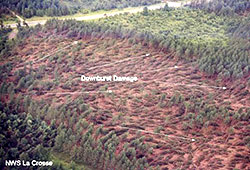 When National Weather Service meteorologists in Louisville, Ky., wanted to enhance the damage surveys they conduct after severe storms strike, they reached out to general aviation pilots for help.
When National Weather Service meteorologists in Louisville, Ky., wanted to enhance the damage surveys they conduct after severe storms strike, they reached out to general aviation pilots for help.
An informal collaboration is taking hold. And the resulting product shows enough promise that in October the meteorologists will give a presentation before the National Weather Association’s annual meeting in Birmingham, Ala., on how aviation helps them use the team approach to rating tornadoes and assessing severe weather in the Ohio Valley.
The idea took hold about two years ago. John Gordon, meteorologist in charge of the National Weather Service Louisville office, saw that aerial storm damage surveys could be especially useful in rural or wooded areas inaccessible to the ground-based teams deployed to assess the impact of tornadoes or what meteorologists call “straight-line winds.”
An aerial perspective also can help determine whether a tornado struck as an embedded feature in a larger weather system. The tipoff to a tornado is a convergent damage pattern, suggesting rotation; a divergent footprint would be seen from straight-line wind.
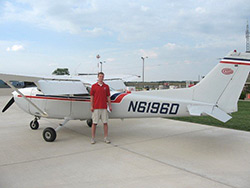 Staff meteorologist Brian Schoettmer, a private pilot since 2007 and the office’s aviation program leader, ran with the idea. He designed a flyer to inform area pilots about the opportunity to help with weather research by volunteering to photograph the aftereffects of storms. Then Schoettmer hit the road to spread the word, covering eight airports in two days of legwork.
Staff meteorologist Brian Schoettmer, a private pilot since 2007 and the office’s aviation program leader, ran with the idea. He designed a flyer to inform area pilots about the opportunity to help with weather research by volunteering to photograph the aftereffects of storms. Then Schoettmer hit the road to spread the word, covering eight airports in two days of legwork.
Schoettmer didn’t know what to expect, he told AOPA. He worried that he might be asking a lot of pilots—inviting them to spend their own time and money on a potentially difficult task.
Now he’s encouraged. After he visited the airports in the western and northwestern portions of his weather territory, and gave a presentation before one flying club, five pilots have signed up for volunteer duty.
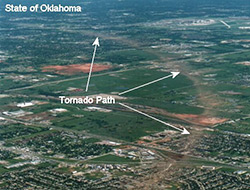 On April 26, severe weather struck the area. Three days later, two of the first volunteers, pilots Roy Cantrall and Glen Norman, went up in Cantrall’s Piper PA-28 to check things out. Their aerial assessment documented damage from two tornadoes.
On April 26, severe weather struck the area. Three days later, two of the first volunteers, pilots Roy Cantrall and Glen Norman, went up in Cantrall’s Piper PA-28 to check things out. Their aerial assessment documented damage from two tornadoes.
Their flight also helped meteorologists conclude that a suspected tornado touchdown reported by ground witnesses in another spot was a false alarm. Resolving that question, which had been the subject of a lot of local conjecture, demonstrated a unique capability of aerial surveying.
“A lot of things look like tornadoes but aren’t,” Schoettmer said.
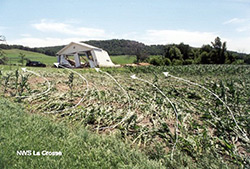 Aerial inspection also might find evidence of tornadoes that touch the ground in unpopulated or wooded areas and would never be detected from the ground, he said.
Aerial inspection also might find evidence of tornadoes that touch the ground in unpopulated or wooded areas and would never be detected from the ground, he said.
When you read or hear about a tornado that was rated on the enhanced Fujita scale, it is Schoettmer or his National Weather Service colleagues who assign the number, say an EF-3, based on information gathered from damage assessments. Structural engineers contribute to the process by analyzing the force of wind it took to damage particular structures.
For big events—usually EF-3 tornadoes or greater, Schoettmer said—the Civil Air Patrol might fly a mission. At other times, relying on volunteer pilots who can respond on short notice and inspect a specific location is proving valuable.
Severe weather is only part of the job. If you have ever checked weather before flying and wondered who composes the terminal aerodrome forecasts (TAFs) shown along your route, that too is the handiwork of Schoettmer or one of his colleagues in National Weather Service’s 122 offices.
For Schoettmer, weather and aviation just seemed to fit. While in high school, he had a job at a bowling alley adjacent to Greensburg Municipal Airport in Greensburg, Ind. His uncle Tom Schoettmer and other pilots would meet there of the mornings to swap stories.
“They’d have the world’s problems solved by 9:30 every morning,” Brian said. “It was a neat group of people.”
Brian flew with his uncle in an assortment of tailwheel singles. He started taking flying lessons during his college days in Shelbyville, Ind., in a Cessna 172 with flight instructor Darrell Shrader.
While Schoettmer was earning his degree in operational meteorology and climatology at Ball State University—famously the alma mater of TV talk show host David Letterman—an opportunity to serve an internship at the aviation unit of the Anchorage, Alaska, office of the National Weather Service came along. Schoettmer credits his getting the spot, in part, to his flying.
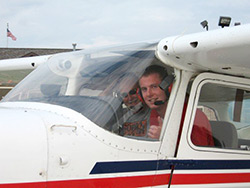 Now, “I’m really right where I want to be,” he said.
Now, “I’m really right where I want to be,” he said.
Asked for any words of wisdom for fellow pilots about how to study weather for flight training, Schoettmer offered this advice (which would make any CFI proud):
“Don’t take the weather portion as something you just have to learn to pass the test,” he said. “Take it seriously, and try your best to understand the material. Weather is something that could come back to bite you.”
It can be a challenging subject, he said. “Sometimes you may have to dig.”



